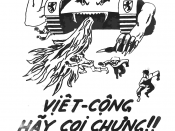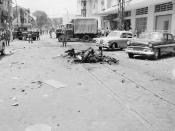Vietnam War The Vietnam War was a war between Vietnam and the United States and the French. It started in May of 1954 and lasted until April of 1975. (Karnow, 11) It was a war to stop the spread of communism throughout Vietnam and have France regain power over Vietnam again.
The Vietnam War was the second of two major conflicts that spread throughout Indochina. The first was mainly between the French and the Vietnamese. The Vietnam War started because Vietnam gained independence from France in 1954 and split into two parts the north and south. The South had an anti-communist government and the North had a communist government. France wanted to regain power over Vietnam, and a war began.
During the war Viet cong was started and it became the national liberation front of South Vietnam. It included all groups that opposed Diem and U.S. (Grolier, 193) Ngo Dinh Diem had power over South Vietnam at this time.
Diem's Military was the army of the republic of Vietnam (ARVN). Ho Chi Mihn had power over North Vietnam. Mihn was the leader of the Viet cong. United States was believed to be in the war because they thought that if one Southeast Asian country fell under communist government that others would follow. The ARVN lost the battle of AP BAC in January 1963. (Grolier, 193) France withdrew from the war because of a defeat at Dien Bien Phu. Then the war was about stopping the spread of communism not about France regaining control over Vietnam.
South Vietnam's situation became critical in 1963. Buddhist monks began protesting religious persecution. Diem refused to soothe the Buddhists. The United States did not want the war to be lost so they supported a group that over threw Diem on November 1, 1963.
Over the next couple of years Hanoi increased its military forces in South Vietnam. In the south he had 35-40 battalions and 35,000 guerillas and 80,000 soldiers not belonging to any certain group.
On August 2,1964 an American destroyer in Tonkin gulf was attacked by North Vietnamese torpedo boats. On August 4th a second destroyer was also attacked. Viet cong attacked U.S. army barracks in Pleiku. United States struck back with massive bombing against North Vietnam. Then U.S. sent 50,000 soldiers to protect air bases.
America decided to get more involved in the war by bombing selected areas and using massive firepower against Viet Cong and North Vietnam. (Grolier, 194) Viet cong used guerilla tactics. Guerilla tactics are jumping out in front shooting and running taking down as many men as possible without getting shot.
On January 30, 1968 the attacks on bases and cities began, it was a new offense Hanoi planned. The first city to be attacked was Tet. Viet Cong was hitting the important capitals and cities. They also made an attack on the U.S. embassy in Saigon. The attack on the embassy failed but is shocked the U.S. that they tried. The Tet offense continued for three weeks. The Tet offense was a major turning point in the war. The communist lost 40,000 soldiers but it showed they would attack secure cities. In the next few months president Johnson would send in 20,000 more troops bringing U.S. troops to 549,000.
In April 1970 when Lon Nol of Cambodia decided not to allow the movement of communist troops through his country because Hanoi pressured Cambodia U.S. forces protected the border. (Grolier, 195) They were withdrawn in June. ARVN attacked Cambodia in February 1971. The mission avoided disaster through U.S. air strikes. U.S. troops dropped to 175,000 by the end of 1971.drug and alcohol abuse widely spread throughout U.S. servicemen. Racial problems increased between white and black soldiers. Veterans of Vietnam War organized an antiwar movement.
Hanoi launched an attack on the south in march 1972. President Nixon struck back with massive bombing and air strikes to areas under attack in South Vietnam. Nixon ordered the mining of Haiphong harbor and a naval blockade in North Vietnam. U.S. bombing stopped the Easter offense. China and the USSR increased aid to Hanoi.
Nixon was reelected in November of 1972. Nixon ordered bombing for 12 days starting December 18. Bombs were being dropped in Hanoi and Haiphong. In the end fifteen planes were shot down 44 pilots captured and 1,600 civilians died. When the bombing was over each side wanted to negotiate. Hanoi's troops were very badly damaged. Six days of negotiating produced an agreement. Paris accord signed January 31, 1973. It gave U.S. withdraw and release of POWs. The last POWs were retuned in March.
In spring 1973 Nixon was not as involved because of the water gate scandal. New fighting made Theiu declare the start of a third Indochina war in January of 1974. Theiu was the new leader of South Vietnam. Nixon had to resign because of the Watergate scandal. Hanoi started a campaign to gain power over Saigon. Theiu recognized the seriousness of this and resigned and fled the country. Duong Van Mihn became leader and surrendered to the north on April 30. The Vietnam War was recognized as a conflict not a war. The veterans harbored bad feelings because there was no ceremony when they returned. Every year on Memorial Day weekend thousands of motorcyclists ride through the streets of Washington because they believe there are still bodies of American soldiers and there are still POWs in Vietnam.


